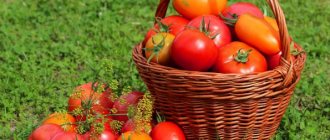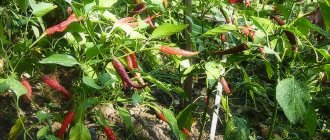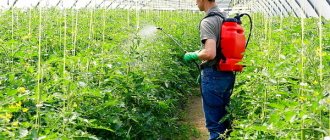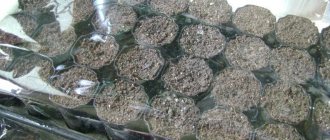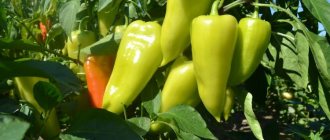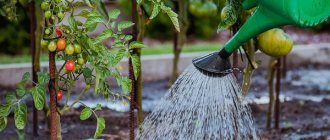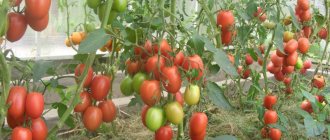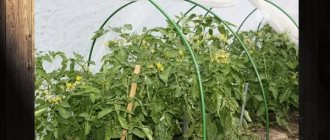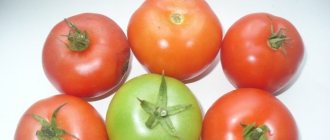Good day! Finally I got to the topic of growing tomatoes in open ground. I have long wanted to write an article. We will discuss all the nuances, soil, fertilizers, watering, the need for pinching, and the features of planting seedlings. In addition, I will mention my predecessors, because crop rotation cannot be underestimated. Be sure to read the article to the end, each section is written for a reason, all this is important if you want to get a good harvest of tomatoes. Moreover, at the end I talk about the common mistakes of all beginning gardeners. So please read to the end to avoid committing them! I tried for you.
By the way, I recently wrote an article about planting tomatoes in a greenhouse. There is also a lot of interesting stuff there, so I recommend reading it here.
Soil preparation and fertilizers
Before planting tomato seedlings, you need to carefully prepare the soil. The best soil for growing tomatoes is light loamy and cultivated sandy loam, protected from the north, well-warmed areas with increased relief. Prepare the soil in the fall:
- remove previous crops and weeds;
- carefully dig it up to a depth of thirty centimeters;
- apply organic fertilizers.
The amount of fertilizer depends on the fertility of the soil, usually from 5 to 10 kg/sq.m.
Humus is usually applied in the spring, before planting seedlings, and manure, compost and peat are applied during the fall season. If the soil is infertile, then organic fertilizers are required. If it is highly fertile, only mineral fertilizers are used in the recommended proportions or together with organic ones.
In early spring, the plowed land is harrowed and two pre-planting loosenings are carried out (one to a depth of 15 cm, the other to 10). In the second case, mineral fertilizers are applied: 20 grams of potassium chloride and 80 grams of superphosphate per square meter. Nitrogen fertilizers are applied in the form of fertilizing.
Frost protection
If you plant seedlings in the ground early, you can get an earlier harvest and increase the fruiting period. However, there is a risk of death of the planted plants from frost. In most cases, tomatoes die at temperatures from +2 to -1˚С.
It is most effective to make a general film cover for the entire bed. To do this, it is convenient to dig wire arcs onto which the film is stretched when it gets colder. If during the day the temperature does not rise above 15˚C, the film does not need to be removed.
You can make individual shelter-caps from paper, fabric, film, boxes - any material that can be used to cover a tomato bush, creating your own microclimate under it.
Predecessors
If you grow tomatoes on the bottom for 3 years, then the yield will subsequently drop by fifty percent, due to the fact that the same elements of mineral nutrition are removed from the soil and due to the massive damage to plants by pests and diseases that are increasingly developing in the soil . Excellent precursors for tomatoes are:
- legumes (except beans);
- carrot;
- onion;
- cabbage;
- cucumber.
It is forbidden to plant tomatoes after nightshade crops (potatoes, eggplants, peppers).
You can plant after these vegetables.
You can return to the same place after four years.
Transplanting
Seedlings are planted in open ground in early June, around the tenth. The night before planting, the seedlings should be watered well; their survival rate will be better, which means they will begin to bear fruit earlier.
For preventative purposes, seedlings should be treated with a one percent solution of Bordeaux mixture or other preparations containing copper.
The height of the seedlings should be no more than 40 cm with a stem thickness of 1 cm, on which there should be 8-10 leaves, an inflorescence with large buds or already opened flowers.
In pre-prepared holes with a depth of 20 and a diameter of 30 cm, according to the planned planting pattern (usually in a checkerboard pattern), the seedlings are planted vertically and the stem is filled up to the cotyledon leaves, five centimeters above the upper edge of the nutrient cube.
Overgrown seedlings should be planted obliquely in elongated holes of the same depth as in the first option, removing the three lower leaves.
The first inflorescence should remain above the soil surface. The soil around the lower part of the stem and roots is compacted to ensure rapid establishment of seedlings and preserve the flowers of the first cluster.
Overgrown tomato seedlings
Yes, I almost forgot, before planting, two handfuls of humus are added to the holes and mixed with soil and water. It is advisable to plant seedlings in the evening or on cloudy days, then the plants take root well, get sick less and grow better.
Other landing nuances
The key to a good harvest is strong, healthy seedlings. It is better to grow it in cups, put three seeds in each, if they all sprout, pull out one root and leave two. So plant two roots in one hole: they should grow together and turn into one powerful stem. To make the fusion process faster, tie the cuttings together with a cord. This technique allows you to reduce the number of plantings by half, which means less watering and weeding.
Seedlings in cups
When planting seedlings in open ground, water the soil with potassium permanganate, one liter of saturated pink solution per hole. Potassium permanganate works as an antiseptic and provides two microelements that are very necessary for plant development: potassium and manganese.
Potassium permangantsovka
It would not be superfluous to add 25-30 g of wood ash under each root; it contains the elements necessary for tomatoes: calcium, phosphorus, potassium. Tomatoes are responsive to fertilizing with ash - the taste of the fruit improves and the yield increases.
Wood ash
The German way of planting tomatoes in open ground
One friend shared with me her experience of this technology for planting tomatoes in open ground. She said that this method belongs to German agricultural technicians, but at our Russian dachas it is very appropriate, since the most common, but very nutritious nettle is used.
- Take young nettle bushes. One twig or 4-6 leaves will be needed per hole. You don’t need to put a lot, otherwise the effect of fattening our tomatoes may occur.
- Prepare a hole and, having slightly broken a sprig of nettle, sprinkle it with a layer of earth. Then plant the tomato seedlings in the hole. As for fertilizers, only compost mixed with soil can be placed in the hole. After planting, water the tomatoes.
- As soon as the water is absorbed into the soil, you need to sprinkle a small layer of nutritious soil on top - a mixture of soil, compost and vermicompost. This will be a layer of mulch for the tomatoes, which will prolong the retention of moisture in the soil. No other fertilizers are needed for tomatoes. Nettle will do its job.
- After planting tomatoes, do not water them for 7-10 days. In dry weather - 5-7 days.
Vermicompost
Complete bush formation
Further care is not necessary, but is recommended for gardeners to obtain strong and fleshy fruits. Forming the crown of a grown plant and pinching the stepsons will allow you to harvest only a large harvest that matches the description given by the manufacturer on the back of the selected seeds.
It is not possible to form bushes for all tomato varieties, but only for varieties with a powerful stem and spreading branches. The greater the growth of the bush, the more fruits can be obtained when harvesting, with proper care. Agronomists recommend leaving one stem for residents of Central Russia, as well as residents of Siberia and the Urals. But gardeners living in the Krasnodar Territory and Kuban, the Crimean Peninsula, can grow each bush, leaving 2 or even 3 stems. A long summer will allow you to harvest more crops in the same area.
For beginning gardeners, it will not be difficult to form a full-fledged plant. To leave only one stem for a tomato crop, it is enough to cut off all the stepsons formed in the pauses of the leaves in time. The procedure should be carried out at the initial stage of their formation, until their length reaches 5 cm. If the summer resident is late, the tomato can shed all its flower stalks and ovaries, extending its vegetative ripening for several weeks.
To form tomatoes with two stems, you should cut off all the shoots except one. The side one formed on the main one must be left. If the plant has formed several shoots at once, the strongest one is selected.
Stepchildren should never be cut off. It is enough to correctly cut off the shoots, pulling the shoot down so as not to injure the main stem. Pulling towards yourself or using pruning shears is prohibited! The plant will thus lose more juice.
Important!
Any care after planting in open ground, including the formation of tomatoes, cannot be carried out during prohibited and unfavorable phases of the Moon. Particularly dangerous are the periods of the New Moon and Full Moon. If you wish and have free time, it is better to choose one of the favorable days calculated by astrologers according to the Lunar calendar.
Stepping should be done throughout the entire growing season. If this rule is neglected, the fruits will be small, similar to cherry fruits. However, in order not to harm the plant, it is more correct to carry out the procedure in the evening or during cold weather, when the loss of sap for the plant is not as important as during drought.
As soon as cold weather comes to the region and an anticyclone of rain begins, it is worth paying special attention to the formation of the crown and the removal of the lower leaves. Pruning will allow the bushes to ventilate better and receive more heat when heated on a hot summer day.
From the beginning to the end of August, it is necessary to pinch the main stem. Stopping growth will allow the fruits to gain greater weight and proper shape. The juice of the plant will be used for better fruiting and taste of each tomato. In addition, such care will have a positive effect on the taste of the fruit, making the tomatoes sweeter.
How to stimulate additional root growth
You can do without tying up the bushes. Place tall tomatoes sparsely, at a distance of 70 cm from each other. Leave 4-5 lower stepsons; when they grow, bend them down and cover them with earth. Also place the central stem on the soil and sprinkle it up to the stepsons, do this when pimples appear on the stem. This will give additional roots, and you can safely leave 5-7 flower clusters on each stem.
By default, low-growing tomatoes do not require a garter; they can be planted in a row, at a distance of 50 cm from each other. This makes watering easier, just throw the hose in a row, when the water reaches the last root, remove the hose. Definitely spud up.
Timely removal of leaves has a beneficial effect on the quantity and quality of fruits. It is necessary to remove the excess leaves that thicken the bush, as well as the lower yellowed leaves, which no longer bring any benefit to the plant.
Organic fertilizers for tomatoes
To increase the ovary on plants, spray the bushes with a solution of boric acid, one sachet (10 g) per bucket of water. This should be done when the second flower cluster appears, and repeat after a week.
Tomatoes need to be fed throughout the summer. They respond well to watering with herbal infusion, whey solution - a liter of whey per bucket of water.
Contributes to obtaining a good harvest “mash” - a fertilizer made from yeast and sugar. Dilute a packet of dry yeast and a glass of sugar in three liters of warm water. Ferment for three days, then use. Dilute 100 g in a bucket of water and do root watering. To enhance the effect, mulch the tomato bushes after watering.
Fertilizer made from yeast and sugar
Proper watering of tomatoes
When growing tomatoes, it is important to properly water throughout the growing season. This is due to the fact that tomatoes are very sensitive to a lack of moisture in the soil and, if watered incorrectly, significantly reduce the yield.
Tomatoes growing in open ground should only be watered with warm water. The period of flowering and fruit set in tomatoes is critical, so it is necessary to increase the rate and frequency of watering.
You can water tomatoes in different ways - in furrows, using drip irrigation and sprinkling. I used these methods for several years and settled on one method.
Drip irrigation technology
Sprinkling
This method of irrigation has the only advantage: the water is evenly distributed over the surface, since irrigation rates can be adjusted. However, this kind of watering always made my tomatoes sick, this was due to the evaporation of moisture from the surface of the soil. Therefore, this method of watering tomatoes in open ground did not suit me.
Sprinkler technology
Drip irrigation
Thanks to modern technologies, caring for plants becomes easier every year. Thanks to drip irrigation, moisture is distributed evenly in the soil among the tomatoes. Water immediately flows to the root system. The only disadvantage of this irrigation method is the price of the equipment. After all, not every gardener can afford to buy such an irrigation system.
Along the furrows
Therefore, I adhere to the old method that our grandmothers watered. When watering along furrows, water is delivered directly to the root system, which improves the growth and development of plants.
Furrow irrigation technology
With such watering, diseases practically do not spread, since water does not reach the aboveground part of the tomatoes. The only disadvantage of this method is the laboriousness of the process. But the result in the form of a bountiful harvest is worth it.
Secrets of caring for tomatoes in open ground
Planting care includes: loosening the soil, pest and disease control, pinching, pinching, hilling, frost protection, etc. Mulching is used for better temperature and water-air conditions for tomato plantings, especially on heavy soils, which later warm up in the spring and lose a lot of moisture in summer. This happens as a result of the formation of a soil crust, which is not very good. To prevent a crust from forming, it is necessary to systematically loosen and moisten the soil.
Suitable for mulching: sawdust, straw, peat, humus, film. The sawdust is not placed fresh.
Mulching tomatoes with sawdust
About frosts
From frost you can use:
- burlap;
- paper caps;
- I'm horning;
- smoke fires.
Saving tomatoes from frost
If the frosts are prolonged, then the plants must be heavily hilled, and after they leave, freed from the ground.
If the plant is well rooted, then when the upper part of the seedling freezes, side shoots quickly appear and, despite the frost, you can get a good harvest.
To reduce the likelihood of plants being damaged by frost, tapes of tall-stemmed plants (curtains), such as beans, peas, corn, sunflowers, are used, placing them across the direction of cold winds, in the middle of the area. Also in the summer, the curtains will pay off by protecting the plantings from dry winds for better conservation of moisture in the soil.
Tall plants
About weeds
Weeds have a very strong and negative effect on the development of tomato, the damage from which is comparable to the damage from drought, diseases and pests, since 1 weed produces more than twenty thousand seeds that are viable for twenty years.
To effectively control weeds, it is necessary to apply a set of measures:
- mulching the soil with white or black film;
- hand weeding;
- organization of mini-crop rotation, which involves not only the use of plants that successfully compete with weeds and suppress them (corn, potatoes, peas, etc.), but also a set of soil cultivation techniques that restrain its clogging.
Mulching with film
More about watering
Tomatoes should be watered along the furrows or at the roots, avoiding water getting on the fruits and leaves. If there is insufficient rainfall, watering is done once a week with cold water, soaking the soil to a depth of 30 cm.
At the first fruit set, water more abundantly and regularly.
During fruit growth, the need for watering increases. At this time, you should not take long breaks, as the fruits may crack if you start watering them suddenly after a drought.
With a lack of water, tomatoes become not only rough and flabby, but also bitter.
After watering, it is necessary to hill up the stem and loosen the soil so that additional roots are formed and plant nutrition is enhanced.
In order not to damage the root system, it is necessary to loosen the soil to a depth of 15 centimeters, and three weeks after planting to about 7 centimeters.
About tying
Plants need to be tied up if they have already taken root and started growing.
Tying tomatoes
About fertilizing
During the growing season, three feedings are done.
- Two weeks after planting, the first one is carried out (fifteen grams of superphosphate and ten grams of ammonium nitrate per square meter).
- At the beginning of fruit formation, a second one is made (fifteen grams of potassium sulfate and ten grams of ammonium nitrate per square meter).
It is better to feed during watering. The solution is applied to the grooves at a distance of twenty centimeters from the plant. When watering is completed, the row spacing is loosened and the holes are sealed.
It is not bad to use organic fertilizers for fertilizing:
- bird droppings (one in ten);
- slurry (one to five);
- mullein (one to five).
Mineral fertilizer is applied depending on the condition of the plants. If there is stunting or pale coloration, you should feed them with mullein.
If the plant fattens, that is, increased growth of stems and leaves occurs, nitrogen fertilizers are excluded.
Important points:
- If flowers fall off and the leaves on the inside become purple , then the plant needs phosphorus . When there is an excess of it, the leaves turn yellow .
- If the plants begin to dry out and the fruits become variegated in color , this indicates a lack of potassium , and if dull spots appear on the leaves, this indicates an excess of potassium .
- The leaves curl - superphosphate is excluded , and the dosage of nitric and potassium fertilizers is increased to thirty grams per bucket of water .
Tomatoes fatten
About protection
After planting the seedlings, approximately two weeks later, the plants must be treated with a one percent solution of Bordeaux acid, protecting them from late blight.
Manifestations of late blight
Against viral, fungal, and bacterial diseases, it would be good to treat with copper oxychloride, dithane cupromix, and dithane M-45. 5 such treatments are done. They stop making them two weeks before the fruit appears. At a later date, the plants are sprayed with garlic infusion (one hundred grams of garlic or three hundred grams of its waste per bucket of water is infused for several days).
About shaping, pinching and pinching
When growing tomatoes, great attention must be paid to the formation of plants if you want to get a return from them in the form of high yields. It is necessary to timely and regularly carry out pinching (regulating the number of fruits, clusters and shoots), removing some leaves, pinching (adjusting the habit and height of plants).
The first time, stepsoning should be carried out 15-20 days after planting, when the stepsons are no longer than seven centimeters. In the future, the plant will be planted systematically. The stepsons are broken out with a lateral movement, using the index finger and thumb. In order not to injure or infect the plant, under no circumstances should the stepson be pulled out. Stepchildren are usually planted early in the morning; at this time the plants contain a lot of moisture and break off easily. Stepchildren that have outgrown are best cut off with a sharp knife or scissors, leaving a stump of one centimeter.
Growing tomatoes
In low-growing, early-ripening varieties that are grown in greenhouses and in open ground, the plants form one, usually two, sometimes three stems. One stem is left if you want a very early harvest. This removes all the side shoots that form in the axil of each leaf. The formation of a second or third stem is used when cultivation occurs in greenhouses and under film covers.
- With the two-stem form, the side shoots are removed, all without exception, not counting those growing under the flower brush.
- With three stems, a stepson is left under the first flower cluster and one more, the most developed one.
In addition to pinching tall varieties, pinching is used (removing the growing point on the remaining shoots). This is done in order to limit excessive vegetative growth and branching and allows rational use of the plant’s plastic substance and ensures good yield in the early stages. Held in early August. Two leaves are left above the inflorescences with set fruits and the growth point of the shoot is removed. Inflorescences in the phase of beginning flowering and bud formation are also removed.
The first harvest of tomatoes in open ground begins to be harvested as early as the twentieth of July. Tomatoes are harvested every five days. It is undesirable to delay harvesting, as this will reduce the quality of the fruit and its quantity. The harvest ends with the first autumn frosts.
Tying bushes to a support
All tomato varieties need stakes. The support allows an adult, mature plant not to bend to the ground under the weight of its weight.
Tomato tying is carried out a short time after planting in open ground. Care occurs as soon as the seedlings take root in the garden bed and grow by 10-15 cm. The height of each peg should be at least 1.5-2 meters, depending on the variety and weight of the promised fruit.
An alternative to reinforcement can be horizontal trellises. They are used to stretch a metal wire between each row. Tomatoes are tied on nylon tights or scraps of fabric, first tying a triple knot on the wire so that the main stem cannot get hurt or rub against the base of the support.
Soil care (weeding, loosening, hilling and mulching)
Removing weeds that take up space and light, loosening hard soil, mulching and hilling are the main agricultural techniques in caring for tomatoes. Before each watering, the soil is loosened abundantly so that oxygen can penetrate the root system, allowing it to better form and the plant to take root. After planting, the first procedure is carried out superficially so as not to harm the young roots. Using a hoe, loosen the top layer, without going deeper than 6-10 cm. It is better to spend more time on agricultural technology to do everything carefully, without harming the young plant.
Weeds should also be disposed of as they appear. And it’s not just about the aesthetic appearance of the garden bed! The essence of removal is better rooting and space, obtaining the necessary mineral and organic substances of the fruit plant. If the grass is not removed, the tomatoes will develop worse, and the fruits will grow small, different from those shown on forums in photo reviews of experienced summer residents.
After removing the weeds, you can start mulching. To implement it, dried weeds are laid out around each bush, saving the soil from the appearance of new weeds and feeding the crop with carbon dioxide, necessary for the full formation of tomatoes.
Hilling is the last item on the list of agricultural technology necessary for tomatoes. And although this applies to plant care, not all farmers perform the procedure. The controversial effectiveness has been discussed for several years. There is still debate on dacha forums about how important this procedure is. Some gardeners adhere to technology, others do without it, spending their free time on more necessary care.
The point of hilling is to grow additional roots, giving the tomatoes additional support. However, if the selected varieties are tall and branchy, the procedure is unlikely to avoid gartering and driving in stakes. With a height of 1.5 meters or more, you can do without hilling tomatoes, devoting your free time to more useful crop care.
If low-growing or creeping varieties are grown, the procedure is well worth the time spent. Tomatoes will grow strong and fleshy without garters or reinforcement with rebar or a wooden stick.
Advantages of mulching tomatoes in open ground:
- less frequent watering (the soil stays moist longer);
- removing two points from care: loosening and weeding;
- preservation of moisture in both the upper and lower layers of the soil;
- increasing productivity;
- reduction of growing season ripening time.
Components ideal for mulching:
- last year's hay;
- freshly cut grass mixed with humus;
- spruce sawdust;
- humus mixed with purchased soil;
- nettle.
After mulching and abundant watering, it is recommended to check the PH of the soil using test strips. If, when using coniferous material, the soil becomes more acidic, it is recommended to water the beds with nettle water with the addition of wood ash. This composition normalizes alkalinity, making the soil neutral.
Subtleties of pruning tomatoes
Tomato is a bright representative of vegetable crops in our region. Open ground, under the scorching sun, is the main place for growing vegetables. Due to the abundance of sun, the green part of the plant grows, which must be systematically pruned.
Several reasons why you should prune tomatoes.
- Different varieties of tomatoes germinate differently. Some varieties are famous for their large leaves that can block the sun's rays. As a result, the other bush will no longer receive proper sunlight and will not produce the desired harvest.
- It is also worth remembering that planting tomatoes in the ground exposes them to the risk of contracting diseases. Those who have encountered this know that more microbes form in the shade, and due to increased moisture they develop faster.
- Excessive green mass negatively affects the fertility of tomatoes. Vegetable crops spend a lot of energy on maintaining leaves and shoots, rather than forming fruits.
After you have planted tomatoes in the ground, pruning is carried out a couple of times a week. Immediately trim off foliage that touches the ground. The procedure is necessary for a number of reasons:
- when watering plants there is a risk of infection with leaf mold;
- increasing the amount of sunlight hitting the base of the stem promotes growth.
Remove shoots growing towards an adjacent bush. When pruning, the tomato variety plays a significant role. On determinate varieties, 5 stepsons are left, the rest are cut off, and for non-seedling tomatoes - 2-3.
When the fruits ripen, you will need to trim off all the greenery below the fruits of the plant. The final trimming touches include removing the top. Of the total quantity, it is necessary to leave only one ovary with 5-6 leaves, and purposefully cut off the rest. This promotes fruit growth and saturation.
Pruning is a measure to prevent plant diseases and also helps to increase yield. Remember that more does not always mean better.
Complete instructions for growing tomatoes in open ground
The productivity of tomatoes is affected by regular watering, periodic fertilizing with organic fertilizers and pinching. After pruning side shoots, the bush and fruits form and develop correctly.
Before planting tomatoes, you should make sure that the shoots need to be removed.
Untimely removal of stepchildren leads to the following consequences:
- decrease in yield;
- increase in ripening period;
- reduction in fruit weight;
- thickening of plantings, spread of diseases;
- breaking off branches under the abundance of fruits.
The procedure is carried out on an adult plant that has entered into force. The algorithm for forming a bush depends on the variety of tomatoes, the speed of ripening and the climatic characteristics of the region. The emphasis is either on the quantity of the harvest or on the quality of the fruit. For open ground, it is preferable to grow in 2–3 stems, for a greenhouse - in 1.
The rules for pinching depend on the type of tomatoes. In determinate varieties, growth stops on its own - these are low-growing plants. On a bush of this type, 2–3 additional stems are left, that is, the stepsons located close to the top are not removed. Indeterminate varieties grow unhindered and can sometimes reach 2 meters in height. Side shoots of this variety will have to be pinched off throughout the season, leaving only one stem.
How else to determine which variety is determinate or indeterminate - pay attention to what is written on the bag of seeds, this is sometimes noted there. A determinate variety is often called “non-sapling”. And they are misleading by this, since this does not mean that the variety does not have stepsons.
How to distinguish a stepson from a peduncle? There are always leaves on side shoots, even at the very beginning of its growth. There are no leaves on the peduncle at all.
Rules for planting tomatoes when growing them in open ground:
- time: morning hours are chosen for the procedure - there is less chance of infection through the wound;
- length of sprouts: shoots 2–3 cm in length are removed, the long shoot is pinched from above; instruments: actions are carried out with fingers or scissors, the instrument requires disinfection;
- safety: use gloves;
- accuracy: do not throw the shoots on the ground next to the bush.
The shoots are partially removed; it is recommended to keep the stumps 1–2 cm thick. For tall varieties, 3–4 leaves are left under the break point.
Newly bred super-determinate varieties and hybrids do not require pinching. In these species, a programmed number of ovaries are formed, after which growth stops. In Russia, determinate types of tomatoes are predominantly used. Regular pinching increases the yield or quality of the fruit.
Treatment against diseases and pests
Prevention is necessary only in problem areas and in cases of growing tomatoes from seeds collected on your own site. As practice shows, neglect in processing can have a detrimental effect on the fruit pulp, appearance and size. In the worst case, the gardener will receive, instead of beautiful vegetables, their absence.
A suitable solution for treatment is a solution consisting of water and cinnamon or mustard powder. An alternative would be ash and a weak solution of potassium permanganate.
If the PH level is disturbed, you can add charcoal to the soil. The natural ingredient is scattered in handfuls under each bush, and then poured generously with settled water, warmed in a barrel.
If you don’t trust folk remedies, you can use purchased options made by agricultural companies. Among the options: Fitosporin, Trichoderma, Metarizin. The latter cannot be replaced if there are pests on the site, from which the plants have been suffering for many years. They irrigate not only the soil, but also leaves and opened flowers.
If time still allows, you can sow marigolds or dill between the rows. Their aroma will repel pests, allowing the fruit crop to develop favorably without slowing down throughout the entire growing season.
Important!
You should not plant tomatoes in the same places every year! Planting zones should be changed, planting the crop in the former germination zone of potatoes, herbs or bell peppers.
5 useful tips
Growing strong tomatoes is not as difficult as it seems at first glance. Knowing a few secrets and taking proper care, the fruits will be tasty and sweet, corresponding to the description given on the packaging by the manufacturer.
1) To ensure that the tomatoes correspond to the declared information, it is recommended to choose the right variety. The variety will allow you to grow a hefty harvest, provided that the cultivation region is chosen correctly. Some tomatoes develop better in cold environments, while others easily tolerate drought. Swapping varieties intended for southern or northern regions is unlikely to bring results.
2) You can reduce the time in the garden by planting varietal tomatoes that are resistant to diseases and pests. For beginners who have just decided to take up gardening, it is better to prefer low-growing varieties that do not require staking and pinching.
3) If there is enough time for cultivation, you should prefer the classic varieties - marked F1. Hybrids do not require more attention, but produce a good harvest that exceeds traditional varieties in weight.
4) Watering should be done moderately, just like any other care. Excessive overwatering or, conversely, drought, will negatively affect fruiting and fruit weight.
5) If it is not possible to water the tomatoes with settled water, you can moisten the soil with cold water from a hose. The most important thing is not to alternate warm watering with cold watering, so that the crop can better adapt and take root in its permanent place of residence.
5 common mistakes:
early disembarkation. If the air and soil temperatures have not yet warmed up, the planted tomatoes will not be able to survive and produce a harvest. The seedlings will begin to get sick or die at the initial stage;
sprouts too small. Seedlings planted late should not be planted at the usual time. It’s more correct to wait until the sprouts gain the necessary growth and full leaves;
if the roots are poorly buried, leaving them on the surface, the crop adapts less well and may die after a short time;
overgrown seedlings should be planted lying down, with their heads to the north. This will allow the plant to quickly reach the sun and take root. If you do it differently, there is a high probability that the tomatoes will become stressed and stop growing;
care must include all points. If you neglect simple rules, the plant will be less formed and may leave the gardener without a harvest.
Favorable days for caring for tomatoes after planting in open ground in 2022 according to the Lunar calendar:
in May - 2, from 4 to 6, from 15 to 17, from 24 to 26, 30;
in June - from 1 to 8, 12 and 13, 22 and 23, 26, from 28 to 30;
in July - 1, 3 and 4, 9 and 10, 14 and 15, from 23 to 25.
Caring for tomato seedlings after planting in open ground does not differ by region. A small difference may relate exclusively to agricultural technology used in medium- and tall-growing varieties, and absent in low-growing ones. It is recommended to carry out the work regularly, focusing on the advice of agronomists and the Lunar calendar 2022 compiled by astrologers. It will help determine favorable days for watering, shaping, fertilizing and working with the soil, excluding the unfavorable and prohibited periods of the New Moon and Full Moon.
Mistakes when growing tomatoes in open ground
1. One of the mistakes made when growing tomatoes in open ground is transplanting them into temporary shelter ahead of time . Buds blooming on fruit trees serve as a kind of guide that tomato seedlings can be planted under temporary shelter, in a greenhouse or under a film outside. If planted earlier, the stems will develop a purple tint, indicating that the seedlings are getting too cold. The consequence of this will be a slowdown in growth and development, which will resume only when normal nutrition from the roots is established and the stem begins to return to a greenish tint.
2. The second, common mistake is planting tomato seedlings on the same level with the soil . It is much better for the development of the plant if it is planted 15 - 20 cm higher. I observed this picture with some neighbors: tomatoes were planted in ridges, like potatoes, and hilled up. They said that this is what my parents taught me all my life and that I follow their advice. We must pay tribute to this method of planting - tomatoes always grow with a good harvest. Now this is the second year I have been planting in this way, it is very convenient and practical for watering, and during the rainy season the roots of the plants do not “flood”, they create a kind of drainage grooves. I read in one source that such drainage grooves into which water flows can somehow protect tomatoes from late blight.
3. Separately, I would like to say about watering, which some gardeners use, flooding the beds with tomatoes over the entire area, without making grooves or grooves . Such watering “cuts off oxygen” to the root system and negatively affects the supply of nutrition to that part of the plant that is located above the ground. Beneficial microorganisms, aerobic bacteria, which provide the plant with nutrients, may die when “flooded.” As a result, airtight soil may be replaced by microorganisms that are pathogenic.
4. Fertilizing tomatoes with mullein infusion more than 2-3 times per season is . They also don’t like it if you water it frequently with urea, much less put it in a hole when planting it. Allowed in the initial phase of plant development and growth, if necessary, only once; the leaves can only be sprinkled by diluting 0.5 tbsp in 5 liters of water. urea.
5. To avoid damage to the harvest and the tomatoes do not begin to “fatten”, do not make the soil for planting them too oily , adding organic fertilizers in excess of the norm, and starting to put large quantities of cow or bird manure into the hole. It is optimal to put 1 tbsp in the hole when planting. superphosphate and half a glass of wood ash. No more than 1–2 cups of manure is added that has been rotted for 3–4 years.
Means Signor Tomato
Fertilizers can stimulate growth and fruiting
The product is not inferior in effectiveness to the previous one. Signor Tomato is a complex drug with systemic contact action. Among the advantages of this fertilizer are:
- increasing the vegetative mass to the required level;
- reducing the likelihood of infection by viral and fungal diseases;
- increasing the drought resistance and heat resistance of the plant;
- improvement of yield indicators;
- acceleration of fruit ripening.
To treat tomatoes with this fertilizer, 30 ml of the drug is diluted in 5 liters of clean water. This amount of solution will be enough to treat 1 hectare of land. Spraying is carried out when 15% of ripened fruits have already appeared on the bush.
Tatyana Orlova (candidate of agricultural sciences):
Only insecticides or fungicides are systemic or contact-intestinal. The former are integrated into the cell structure and remain in the organs and tissues of the plant for a relatively long time (2-3 weeks) and remain poisonous or simply inedible for insect pests or pathogens. Contact intestinal pathogens cause the death of pathogens when they come in direct contact with them.
